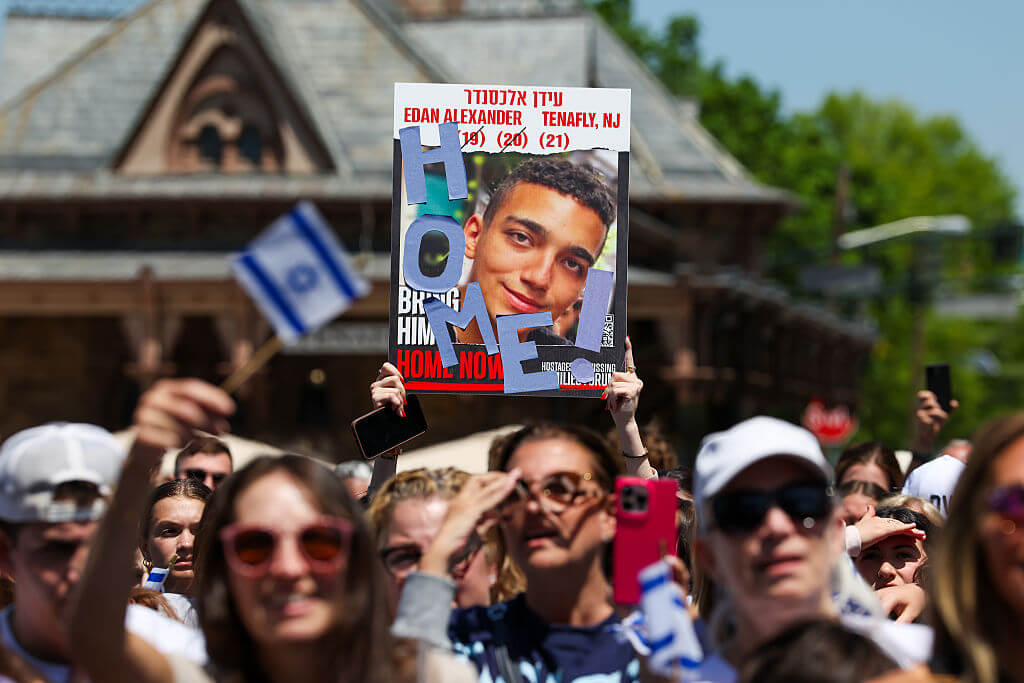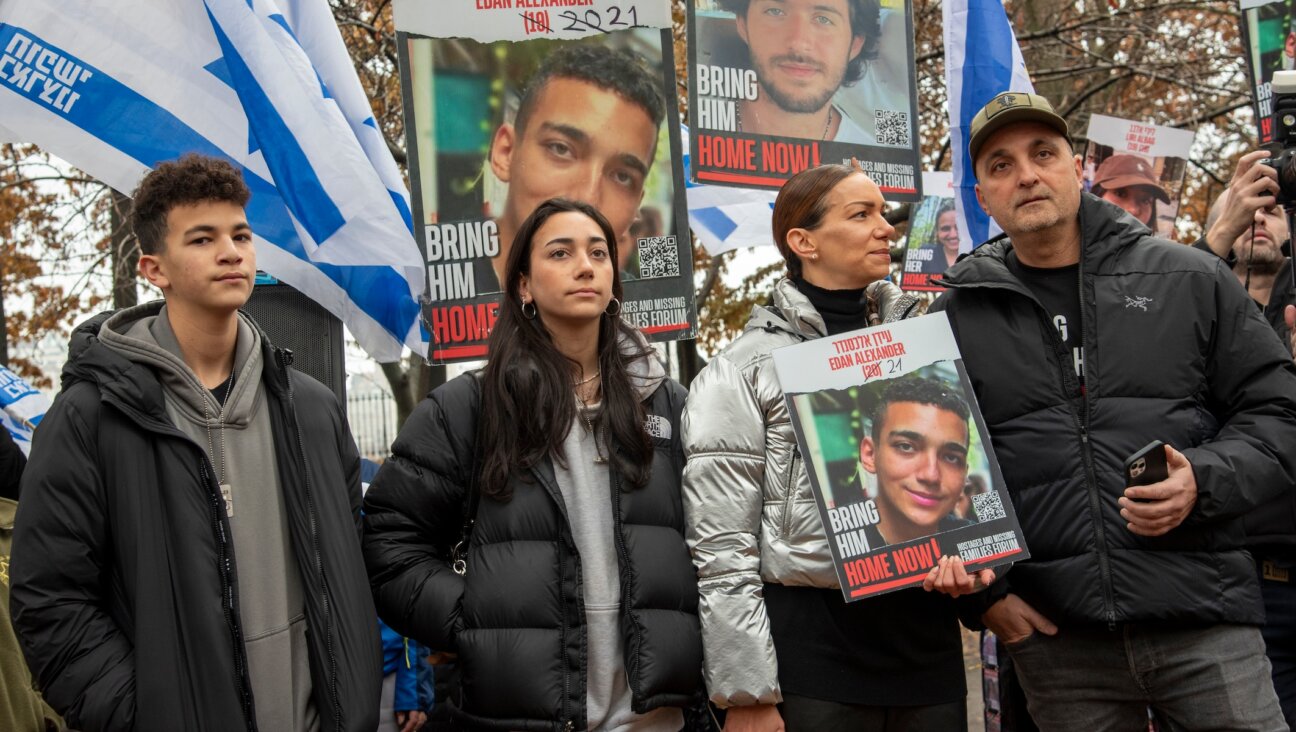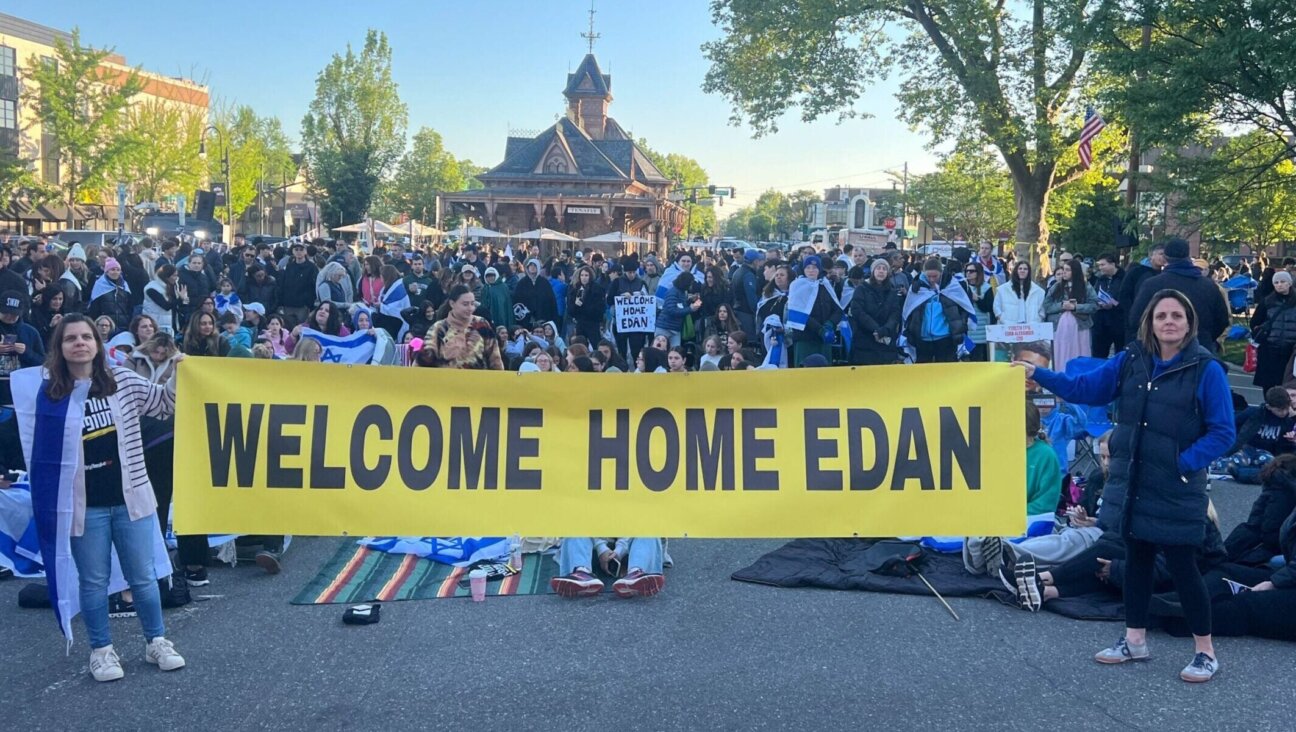Mourners throng Bnei Brak for funeral of Rabbi Chaim Kanievsky, largest in Israel’s history

Jewish mourners wait outside Ponevezh community cemetery in the city of Bnei Brak near Tel Aviv in central Israel during the funeral of haredi Rabbi Chaim Kanievsky, March 20, 2022. (Jack Guez/AFP via Getty Images)
(JTA) — Thousands of men escorted the late leader’s body from his home on Rashbam Street to his final resting place close to the grave of his uncle, Rabbi Avraham Yeshayohu Karelitz (the “Chazon Ish”) in the Zichron Meir Cemetery. Only close members of family and senior public figures, including Israel’s chief rabbis, were allowed into the cemetery for the actual burial. However, thousands of people broke through the police barriers into the cemetery and some were detained.
Women were instructed to stay away from Chazon Ish Street, the main thoroughfare through which the procession would take place, and to stand in a cross street where huge screens livestreamed the eulogies. At several points, the livestream crashed, silencing the booming voice of the eulogizing rabbis. An eerie quiet filled the streets, with only the occasional sob breaking the silence. Women with strollers and small children were crammed together, some sitting on cars and building walls. Faces filled every window of every building lining the streets.
Asked why she had brought her young children, one of whom was crimson from crying, to such a crowded area, Bnei Brak resident Ruchi Cohen answered.
“This will leave an impression on their souls forever. Everyone who can attend the funeral of this gadol hador [giant of the generation] will merit a place in the World to Come,” she said, referring to the Jewish concept of the afterlife.
Cohen added that Rabbi Yerachmiel Gershon Edelstein, Kanievsky’s heir apparent, had instructed that all children over 9 attend the funeral and that all residents of Bnei Brak tear their outer garments, reflecting the traditional Jewish mourning ritual.
Despite concerns about crowd control that prompted Israel to largely shut down for the funeral, there were few major incidents. Several dozen people were treated at the scene by medics and three were evacuated to a nearby hospital after fainting. The MDA rescue service said no serious injuries were recorded.
Earlier in the day, Prime Minister Naftali Bennett had warned that the mass gathering could take a calamitous turn as occurred in 2021 in the northern Israel pilgrimage town of Meron in 2021 when 45 people were crushed to death.
“The funeral is a mass event, and we must make sure that it does not end — God forbid — in a mass disaster,” Bennett said.
“The trauma of the Meron disaster is still fresh for all of us. This tragedy must not be repeated,” Bennett said.
He added that Kanievsky’s death marked “a great loss to the Jewish people.”
According to the Bnei Brak municipality, around 750,000 people had gathered in the one square-kilometer area designated for the funeral procession in the hours before it was due to start.
Hillel Graineman, an EMT with United Hatzalah, explained that many precautions had been taken to avoid what he called, “Meron 2.” Hundreds of ambucycles, 45 ambulances and popup clinics belonging to the emergency organization were stationed around the area and drills had taken place well into the night together with MDA to deal with possible scenarios, especially surrounding the task of crowd-dispersal in the case of an emergency evacuation.
“Everyone knows where they’re supposed to be,” Graineman said. “We learned many lessons from Meron.”
Yoni Danan, who was present during the Meron disaster, said he was nervous to attend the funeral.
“Of course it crosses your mind. I was up last night wondering whether to take my son or not. But how could I not? [Kanievsky] is his hero — he’s every [religious] boy’s hero — I couldn’t take that away from him,” he said.
He said the crowds he witnessed at Rabbi Ovadia Yosef’s funeral in 2013, attended by an estimated 850,000 people, and those the night the Meron tragedy occurred did not compare to the crowds gathered in Bnei Brak.
“I’ve never seen anything like this before,” he said. “Still, it’s not a bottleneck situation like Meron was.”
—
The post Mourners throng Bnei Brak for funeral of Rabbi Chaim Kanievsky, largest in Israel’s history appeared first on Jewish Telegraphic Agency.
The Forward is free to read, but it isn’t free to produce

I hope you appreciated this article. Before you go, I’d like to ask you to please support the Forward.
Now more than ever, American Jews need independent news they can trust, with reporting driven by truth, not ideology. We serve you, not any ideological agenda.
At a time when other newsrooms are closing or cutting back, the Forward has removed its paywall and invested additional resources to report on the ground from Israel and around the U.S. on the impact of the war, rising antisemitism and polarized discourse.
This is a great time to support independent Jewish journalism you rely on. Make a gift today!
— Rachel Fishman Feddersen, Publisher and CEO
Support our mission to tell the Jewish story fully and fairly.
Most Popular
- 1

Fast Forward Ye debuts ‘Heil Hitler’ music video that includes a sample of a Hitler speech
- 2

Opinion It looks like Israel totally underestimated Trump
- 3

Culture Is Pope Leo Jewish? Ask his distant cousins — like me
- 4

Fast Forward Student suspended for ‘F— the Jews’ video defends himself on antisemitic podcast
In Case You Missed It
-

News In Edan Alexander’s hometown in New Jersey, months of fear and anguish give way to joy and relief
-

Fast Forward What’s next for suspended student who posted ‘F— the Jews’ video? An alt-right media tour
-

Opinion Despite Netanyahu, Edan Alexander is finally free
-

Opinion A judge just released another pro-Palestinian activist. Here’s why that’s good for the Jews
-
Shop the Forward Store
100% of profits support our journalism
Republish This Story
Please read before republishing
We’re happy to make this story available to republish for free, unless it originated with JTA, Haaretz or another publication (as indicated on the article) and as long as you follow our guidelines.
You must comply with the following:
- Credit the Forward
- Retain our pixel
- Preserve our canonical link in Google search
- Add a noindex tag in Google search
See our full guidelines for more information, and this guide for detail about canonical URLs.
To republish, copy the HTML by clicking on the yellow button to the right; it includes our tracking pixel, all paragraph styles and hyperlinks, the author byline and credit to the Forward. It does not include images; to avoid copyright violations, you must add them manually, following our guidelines. Please email us at [email protected], subject line “republish,” with any questions or to let us know what stories you’re picking up.














